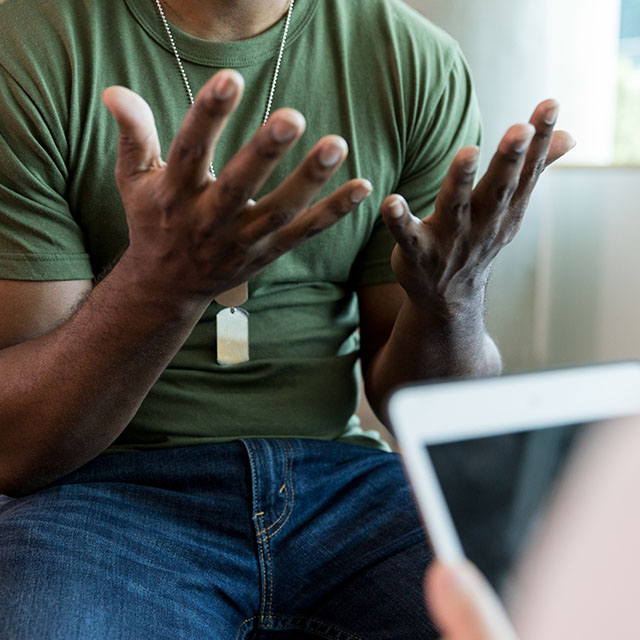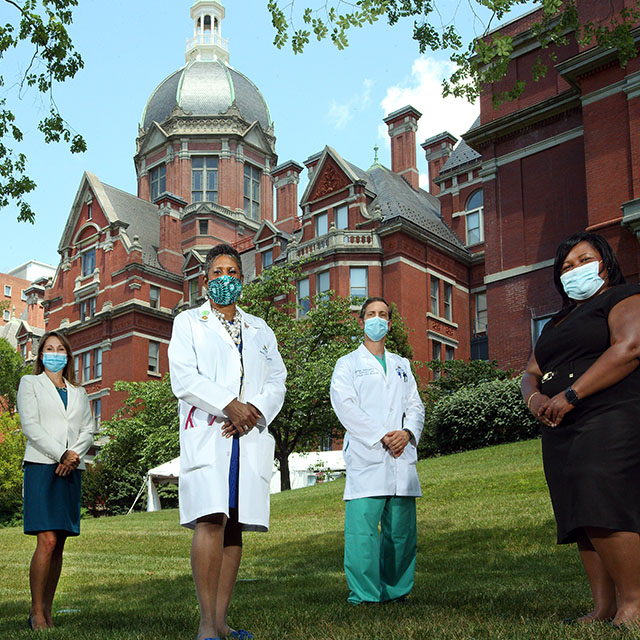After Johns Hopkins clinical psychologist Andrea Young recently spoke to colleagues about racial and ethnic disparities in access to children’s mental health services, she was delighted that many were eager to continue the discussion.
“There was a lot of interest in figuring out what we can all do as individuals to promote mental health equity,” says Young, an assistant professor of psychiatry and behavioral sciences who spoke during the psychiatry department’s monthly Grand Rounds. “There is increased awareness of problems that are significantly impacting the health and wellness of folks who are our neighbors and form a significant part of our patient population.”
During the last two years, the death of George Floyd, a 46-year-old Black man who was killed while in police custody in Minneapolis on May 25, 2020, along with awareness of other high-profile police brutality cases against Black people and the toll of the COVID-19 pandemic, has underscored economic and health inequities, including the disparities Young researches. She says these events have prompted clinicians to think more deeply about how systemic racism, the pandemic and their intersection have contributed to differences in health outcomes and treatment access.
Young, who was appointed assistant dean for graduate biomedical education and graduate student diversity in September 2021, works closely with the Office of Diversity, Inclusion and Health Equity (ODIHE), which is dedicated to making Johns Hopkins Medicine (JHM) a more welcoming and inclusive institution for all. Sherita Golden, JHM vice president and chief diversity officer, says events of the past two years have prompted discussions about structural and institutional racism in health care as well as in other areas of society.
She says that, for the first time, hundreds of “listening sessions” were held across Johns Hopkins, from June to August 2020. More than 1,200 managers and leaders were trained how to facilitate these open, candid conversations during which employees shared with colleagues their thoughts on race and equity issues.
On June 5 of that year, less than two weeks after Floyd’s death, medical residents, postdocs, students and other health care workers knelt together during a national moment of silence in a showing of support for equality and racial justice. The events, which honored Floyd and others who died from police brutality, were organized by the Johns Hopkins House Staff Council and White Coats for Black Lives, and took place at various Johns Hopkins Medicine sites including each hospital.
Journeys in Healing, a town hall series on structural racism and anti-racism, began later that year. Running through 2021, it focused on topics such as racial justice, and the history of structural racism (also called institutional racism) and how it affects health care, law and government, employment, housing and policing.
“Diversity, inclusion and health equity cannot be things that we do on the side, but they must be integrated into our overall JHM strategic mission and objectives,” Golden says. “Our executive leadership — Dean Rothman, Kevin Sowers and Inez Stewart — are clearly articulating to our leaders, managers and staff that everyone, not just the minoritized members of JHM, has a role to play in making our environment diverse and inclusive. They have stated that this is not just ODIHE’s problem to solve.”
A Progress Update on Diversity
In the past two years, 30 leaders from underrepresented backgrounds have been appointed to positions throughout JHM, including department directors and vice deans.
In May 2020, Namandjé Bumpus, Ph.D., was named director of the Department of Pharmacology and Molecular Sciences, becoming the first African American women to lead a department at the Johns Hopkins University School of Medicine and the only Black woman to chair a pharmacology department at a U.S. medical school.
Other prominent appointments of leaders from underrepresented backgrounds include Jessica Melton, M.H.A., as president and chief operating officer (COO) of Suburban Hospital, and Hasan Zia, M.D., M.B.A., as president and COO of Sibley Memorial Hospital.
The number of people from underrepresented in medicine (UiM) backgrounds has also increased among Johns Hopkins learners. In July 2021, the number made up 21% of the incoming intern class, up from 14% in 2019. Graduate student diversity experienced sharper growth in the same time period — Ph.D. students from underrepresented backgrounds grew from 16% to 32% and M.D. UiM students increased from 15.8% to 19%.
The Levi Watkins Jr. Mentorship Program, announced in October 2021, helps support the career development and advancement of assistant and associate professors from underrepresented backgrounds.
Employees of various races, ethnicities, gender identities and sexual orientations, veterans and people with disabilities, and their allies are also empowered by six employee resource groups (ERGs). Three were added in the last two years — groups for LGBTQ+ employees, Asians and Pacific Islanders, and employees with disabilities. The Hopkins Diaspora (for Black/African American employees), Hopkins Familia (for Hispanic/Latinx employees) and Hopkins Veterans ERGs already existed.
In July 2020, the Hopkins Diaspora ERG held a Zoom conversation about race and equality with Ron Daniels, Johns Hopkins University president; Paul B. Rothman, M.D., dean of the medical faculty and CEO of JHM; and Kevin W. Sowers, M.S.N., Johns Hopkins Health System president and JHM executive vice president.
During the conversation, which addressed results from a survey sent to the Black Faculty and Staff Association, leaders announced that Martin Luther King Jr. Day would become a paid holiday throughout the Johns Hopkins Health System (it was already a paid holiday for university employees).
As diversity has increased at Johns Hopkins, so have resources to educate employees about cultural sensitivity, racism and related topics.
Training regarding unconscious bias was rolled out to all Johns Hopkins Health System, school of medicine and JHM leadership in February of last year. More than half of the 6,000 leaders — which include employees at the supervisor and manager level and above, faculty leaders and midlevel credentialed practitioners (physician assistants and nurse practitioners) — have been trained so far. Over 250 residents, 50 fellows and faculty members, and members of the House Staff Diversity Council (which promotes diversity and inclusion among residents and throughout JHM) and the Johns Hopkins Clinical Fellows Council (which supports the needs of school of medicine fellows) have taken allyship training.
“Unconscious bias training is just scratching the surface,” Golden says. “It's the foundation for developing a broader anti-oppression training framework.”
Toward an Inclusive Culture: Acting Against Disrespect and Bias, a new staff education module, is now part of the annual required training for both the school of medicine and Johns Hopkins Health System. Other topics will follow, Golden says.
Vaccine Equity and Community Outreach
While Johns Hopkins was expanding its internal resources for diversity and inclusion, the COVID-19 pandemic exposed health inequities that accelerated the institution’s many outreach efforts to the community.
For the ODIHE, this meant ensuring that accurate information about COVID-19 and, later, vaccines, was reaching historically marginalized and underresourced communities. The COVID-19 Pandemic Anchor Strategy Work Group, of which Golden was a member, helped bring testing for the coronavirus that causes COVID-19 and information to Baltimore neighborhoods through such vehicles as a bilingual vaccine education website, additional bilingual support for Spanish-speaking patients and food distribution to community members.
Once vaccines were available, JHM concentrated on vaccinating its workforce.
“It was absolutely critical to communicate in different ways and let people ask questions,” says Carole Martens, J.D., director of facilities compliance for the Johns Hopkins Health System. “We were looking to identify and eliminate obstacles.” (Martens’ team works to ensure compliance with regulations and focuses on safety, training and support for staff and leadership.)
To reach nonclinical front-line employees, most of whom are Black or Latinx, according to Golden, the ODIHE and the facilities department developed one-pagers with information and QR codes to post throughout work areas, set up myChart activation stations and a vaccine appointment scheduling line, and arranged on-site vaccine clinics that accommodated various working hours.
The facilities department’s divisions of environmental care and engineering displayed photos of “vaccination champions” (employees who were recently vaccinated) on TV screens throughout work areas, which helped spark conversations among employees and inspired confidence in the vaccines.
When vaccination efforts expanded to the community, JHM delivered almost 34,000 doses across Baltimore and Washington, D.C., through mobile clinics at senior housing facilities, recreation centers, shopping centers, churches and schools. The effort, a partnership among ODIHE, the Johns Hopkins Office of Government and Community Affairs, and health system operations, was bolstered by a grant from the Maryland Health Services Cost Review Commission.
The ODIHE also worked with Johns Hopkins researchers and physicians of color to create a YouTube playlist of videos that answered questions about vaccines for JHM employees and the communities they serve.
To further ensure accurate information was reaching the community, the office worked with Heart Smiles, an organization that provides enrichment and leadership opportunities for young people in Baltimore, to create social media posts and videos about COVID-19 and vaccines. Media collaborations with Urban One, AFRO News and El Tiempo helped get COVID-19 and vaccine information to an additional 150,000 people in Maryland and Washington.
Connecting the Dots
For Andrea Young, the events of the last two years as well her new appointment have expanded the scope of her diversity, inclusion and health equity work. In addition to her longtime research on children’s mental health disparities, Young works with her department’s diversity committee, serves as a mentor to undergraduate students from underrepresented groups who are interested in public health and psychology, and is a faculty adviser to a student led-group that promotes equity and anti-racism in clinical psychology training programs. She also coordinated an ongoing mental health equity research talk series for researchers, clinicians and the larger Johns Hopkins community. Topics have included Black women’s experiences with discrimination and oppression, Latinx families’ cultural resilience and experiences of discrimination, and structural racism’s impact on mental health and well-being.
“As providers, we can challenge ourselves to think more about social determinants of health and how we can do a better job of serving our patients,” she says.




